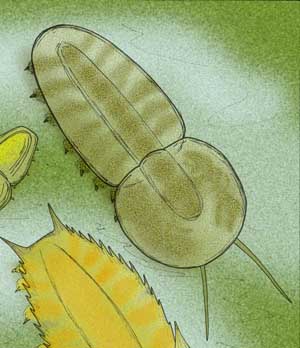Misszhouia
| Misszhouia | ||||||||||||
|---|---|---|---|---|---|---|---|---|---|---|---|---|

Misszhouia longicaudata , reconstruction drawing |
||||||||||||
| Temporal occurrence | ||||||||||||
| Lower Cambrian | ||||||||||||
| Locations | ||||||||||||
| Systematics | ||||||||||||
|
||||||||||||
| Scientific name | ||||||||||||
| Misszhouia | ||||||||||||
| Chen , Edgecombe & Ramsköld 1997 | ||||||||||||
| Art | ||||||||||||
Misszhouia longicaudata is a trilobite-like arthropod species from the Cambrian . It was discovered in 1984 in the Chengjiang Fauna Community of Maotianshan Slate as a very well preserved fossil. It was this find that brought the Maotianshan slate into the focus of science.
description
Fossils of the species reach a body length of just under 8 to about 65 millimeters, on average about 33 millimeters. As with all Naraoiidae, the body consisted of only two articulated tergites, viewed from the dorsal side (above) . In the species, the anterior (front) tergite or head shield is approximately semicircular, the posterior (rear) or tail shield is elongated and noticeably longer and narrower than this. The head shield is rounded towards the joint without cheek thorns. The two shields were uniformly curved on the living animal, the central part was not set off from the side areas. The anterior blind sacs ( diverticula or caeca) of the intestine, which can be recognized by many fossils in the head shield as relief or contrasting areas, are less branched than in the genus Naraoia . Particularly relief sections of the caeaca can be interpreted as glands.
When viewed from below (ventral side) the animal shows a completely different structure. In the central axis of the body sat a row of sternites that were much narrower than the tergites, each sternite had a pair of limbs on its side. A lobe-shaped hypostome can be seen in front under the head shield, behind which the mouth was located. Moved to the side of the hypostome sat two long and narrow antennae that protruded forward over the head shield. In addition, the head shield carried four pairs of extremities, which were pronounced split legs and corresponded completely to the legs of the rear part of the body, so were not pronounced as specially designed mouth parts, although the foremost pair of legs sat at the side of the mouth opening. At the base of the legs there was a thorny appendix (endite), these endites delimited a central channel (food channel). Under the tail shield there were usually between 19 and 22 pairs of legs, with smaller specimens (probably young animals) also fewer.
Phylogeny and Systematics
M. longicaudata was originally considered a member of the genus Naraoia and was therefore named Naraoia longicaudata in the first description . The two genera are very closely related and belong to the family Naraoiidae within the order Nectaspida . The splitting off of the species into its own, monotypical genus is controversial and is not supported in all phylogenetic analyzes.
swell
- JY Chen, GD Edgecombe, L. Ramsköld (1997): Morphological and ecological disparity in naraoiids (Arthropoda) from the Early Cambrian Chengjiang fauna, China. Records of the Australian Museum 49 (1): 1-24.
- X.-L. Zhang, D.-G. Shu, DH Erwin (2007): Cambrian naraoiids (Arthropoda): morphology, ontogeny, systematics, and evolutionary relationships. Journal of Paleontology 81: 1-52. doi : 10.1666 / 06-082.1
Individual evidence
- ↑ Misszhouia (Naraoia) longicaudata at The Virtual Fossil Museum
- ↑ Martin Stein, Graham E Budd, John S Peel, David AT Harper (2013): Arthroaspis n. Gen., A common element of the Sirius Passet deposit (Cambrian, North Greenland), sheds light on trilobite ancestry. BMC Evolutionary Biology 2013, 1:99 pm online